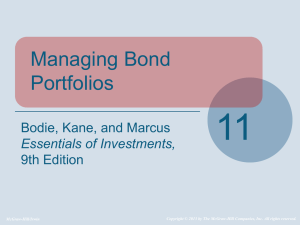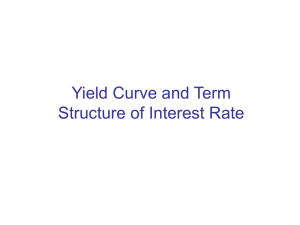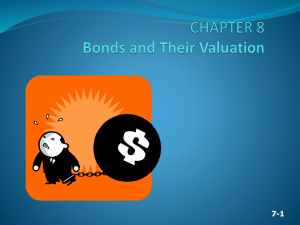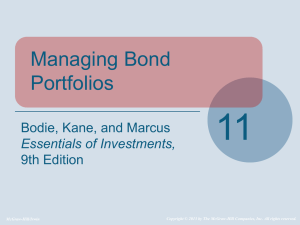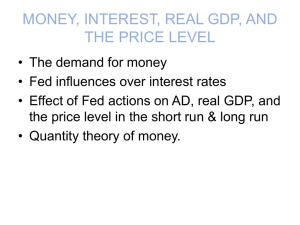IENG 302 Lecture 09: Bonds
advertisement
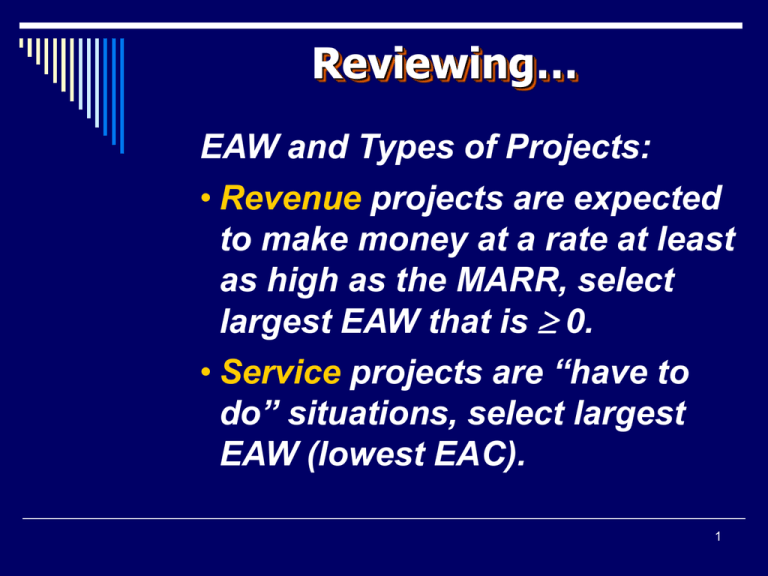
Reviewing… EAW and Types of Projects: • Revenue projects are expected to make money at a rate at least as high as the MARR, select largest EAW that is 0. • Service projects are “have to do” situations, select largest EAW (lowest EAC). 1 Reviewing… For a capital purchase (P) with a salvage value (S), the EAC can be calculated two ways: 1. P(A I P, i, n) – S (A I F, i, n) 2. (P – S) (A I P, i, n) + S*i Annual equivalent Opportunity for loss of value cost 2 BOND TERMINOLOGY 1. Face Value, Par Value, Maturity Value – How much the borrower will pay the holder when it matures. 2. Coupon Rate, Nominal Annual Interest Rate – Nominal yearly interest rate paid on face value. 2. Bond Dividend – Interest paid periodically until maturity 4. Maturity Date – Date at which you receive the face value 5. Market Value, Current Price – What someone is willing to pay for the remaining cash flows. 6. Yield to Maturity – Actual interest rate earned over holding period 3 CFD with Bond Terms… ib = Coupon Rate Dividend Periods / Yr Dividend = (Face Value) (ib) – or – Face Value Coupon Rate Dividend Periods / Yr Face Value Yield Rate = ia = (1+ ib) m – 1 Dividend 0 1 2 3 n periods (to Maturity Date) Bond Price Yield to Maturity = i* such that NPW = 0 4 Problem 1 A bond with a face value of $25 000 pays a coupon rate of 4% in quarterly payments, and will mature in 6 years. If the current MARR is 2% per year, compounded quarterly, how much should the maximum bond price be? 5 Problem 1 Given: MARR = 2% per year, cpd quarterly Face Value = $25 000 Coupon Rate of 4%, paid quarterly Maturity in 6 years Find Max. Price: ib = Coupon Rate = 4% / yr = 1% /qtr. Dividends/yr 4 qtr /yr Face Value = $25 000 Dividend = (Face Value) (ib) = ($25 000) (.01) = $250/pd 0 1 2 3 n = (6 yr)(4 qtr) = 24 qtrs yr Bond Price (maximum) 6 Problem 1, cont. Given: MARR = 2% per year, cpd quarterly Face Value = $25 000 Coupon Rate of 4%, paid quarterly Maturity in 6 years Find Max. Price: Finding effective MARR to match dividend period: MARR = 2%/yr, cpd quarterly, so find a quarterly equivalent rate! a.) Find effective quarterly rate (to match compounding), since pp = cp: r i= m so inserting values and solving for i: 2% / yr i= = 0.5%/qtr. 4 qtrs / yr 7 Problem 1, Cont. Given: MARR = 2% per year, cpd quarterly Face Value = $25 000 Coupon Rate of 4%, paid quarterly Maturity in 6 years Find Max. Price: Finding NPW of remaining cash flows at effective MARR: $25 000 i = 0.5% / qtr. $250/pd 0 1 2 3 n = 24 qtrs Bond Price = $250(P/A, 0.5%, 24) + $25 000(P/F, 0.5%, 24) =$250 (22.5629) + $25 000 (.8872) = $27 822.30 8 Problem 2 You desire to make an investment in bonds provided you can earn a yield rate of 12% per year on your investment, compounding monthly. How much can you afford to pay for a bond with a face value of $10 000 that pays a coupon rate of 10% in quarterly payments, and will mature in 20 years? 9 Problem 2, Cont. Given: MARR = 12% per year, cpd monthly Face Value = $10 000 Coupon Rate of 10%, paid quarterly Maturity in 20 years Find Max. Price: ib = Coupon Rate = 10% = 2.5%/pd. Dividends/yr 4 Face Value = $10 000 Dividend = (Face Value) (ib) =($10 000) 2.5% = $250/pd 0 1 2 3 n = (20 yr)(4 qtr) = 80 qtrs yr Bond Price (maximum) 10 Problem 2, cont. Given: MARR = 12% per year, cpd monthly Face Value = $10 000 Coupon Rate of 10%, paid quarterly Maturity in 20 years Find Max. Price: Annual Bond Yield needs to equal MARR: Yield Rate = effective 12%/yr, so find a quarterly equivalent rate! a.) Find effective monthly rate (to match compounding), so set: 12% = .12 = (1 + imo )12 – 1 and solving for i: 1 imo = (1.12) 12 – 1 = 0.949%/mo. b.) Find effective quarterly rate (to match dividend period): iqtr = (1+ imo) m – 1 = (1+.00949)3 – 1 = 2.874% / qtr Note: 3 mo. per qtr! (Check: ia = (1+ iqtr) m – 1 = (1+.02874)4 – 1 = 12% / yr !) 11 Problem 2, Cont. Given: MARR = 12% per year, cpd monthly Face Value = $10 000 Coupon Rate of 10%, paid quarterly Maturity in 20 years Find Max. Price: ib = Coupon Rate = 10% = 2.5%/pd. Face Value = $10 000 Dividends/yr 4 Quarterly Yield Rate = 2.874% / qtr Dividend = (Face Value) (ib) =($10 000) 2.5% = $250/pd 0 1 2 3 n = (20 yr)(4 qtr) = 80 qtrs yr Bond Price = $250(P/A, 2.874%, 80) + $10 000(P/F, 2.874%, 80) =$250 (31.19054) + $10 000 (.10367) = $8 834 12 Problem 3 A $1 000 face value bond will mature in 10 years. The annual rate of interest is 6%, payable semi-annually. If compounding is semi-annual and the bond can be purchased for $870, what is the yield to maturity in terms of the effective annual rate earned? 13 Problem 3, Cont. Given: Bond Price = $ 870 Face i = Value = $1 000 Coupon Rate of 6%, cpd & paid semi-annually Maturity in 10 years Find Annual Yield to Maturity: $1 000 ib = Coupon Rate = 6% = 3% / Dividend pd. Dividends/yr 2 Dividend = (Face Value)(ib) = ($1 000) (3%) = $30/pd 0 1 2 3 n = (10 yr)(2 divs) = 20 pds yr $870 Find semi-annual Yield to Maturity = i* such that NPW = 0 14 Problem 3, cont. Given: Bond Price = $ 870 Face i = Value = $1 000 Coupon Rate of 6%, cpd & paid semi-annually Maturity in 10 years Find Annual Yield to Maturity: Want NPW = 0 $30 (P/A, i*, 20) + $1 000 (P/F, i*, 20) = $870 Try 4% $30 (P/A,4%, 20) + $1 000 (P/F, 4%, 20) = $ 864 Low! $1 000 Try 3% $30 (P/A,3%, 20) + $1 000 (P/F, 3%, 20) = $1 000 High! Dividend = $30/pd Still need to come up with a closer value … 0 1 2 3 n = 20 pds $870 Yield to Maturity = i* such that NPW = 0 15 Problem 3, cont. Given: Bond Price = $ 870 Face Value = $1 000 Coupon Rate of 6%, cpd & paid semi-annually Maturity in 10 years Find Annual Yield to Maturity: Need to interpolate: 4% $ 864 (Low), 3% $1000 (High), Find x% = $870: x% – 3% = 4% – 3% 870 – 1000 864 – 1000 x = 3 + 130 = 3.96% / 6 mo. 136 Need to convert semi-annual (6 mo.) yield rate to Annual Yield Rate: Yield Rate = ia = (1+ i6 mo) m – 1 ia = (1+ .0396) 2 – 1 Annual Yield to Maturity = 8.08% / yr ! 16

